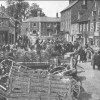Weymouth in summer and Weymouth in winter are two very different towns. Only four months ago, holiday makers packed the beach and ice creams were being consumed by the thousand. In winter, the town is peaceful and as the civic Christmas tree twinkles in Bond Street, the magnificent seasonal lights give St. Mary and St. Thomas Streets a truly magical feel.
As locals in coats and scarves move quickly round the streets and only the hardy in search of good sea air brave the seafront, we locals notice how very different Weymouth is in winter. Truthfully, most of us prefer it that way. Only a few months ago, bikinis and swimsuits were the order of the day. The popular Punch and Judy show – was knocking seven bells out of the constabulary and sausages! The red and white striped booth is the very epitome of the seaside – on “the best beach in the best bay of the best resort,” says us.
Holidaymakers once came on a Saturday and left the next Saturday, but there is a new breed these days. Usually car borne, they leave decisions to a much later stage and if they see a dark cloud in the sky, they won’t go near the coast. Worse still, if the previous day’s forecast is bad, they decide at that point not to come.
Situated in a magnificent bay surrounded by a ring of hills, Weymouth has its own microclimate – it can be fine here and raining through much of the hinterland. Three television franchises border Weymouth and their misleading forecasts often refer to areas fifty or more miles away.
Summer brings other problems. Traffic is the major difficulty in season – sometimes at a standstill five miles back over the Ridgeway, almost as far as Dorchester. All this traffic pours into a small medieval street plan, on a narrow tapering sandspit, limited by the River Wey and the sea. Space is precious and car parks soon get filled. That’s good news for local council taxpayers who pick-up £2.3 million from parking – assisted by razor sharp enforcement from the Borough’s traffic wardens. As a local, it can be frighteningly difficult to get around in summer.
Back to my favourite seafront seat by Brunswick Terrace, from which so much of Weymouth Bay is in view. The pretty Greenhill Gardens are to the north. Queen Victoria’s statue stands outside St. John’s Church of 1854 – whose magnificent spire is one of the town’s greatest landmarks. The now-demolished seaward platform of the Pier Bandstand on concrete stilts, used to host events as diverse as Miss Weymouth and wrestling.
Of more sombre purpose is the Cenotaph, where on Remembrance Sunday in November and on Veterans Sunday in June, traffic is stopped while the Mayor leads the town’s homage to locals who died in conflict. Walking south, the Jubilee Clock of 1887, built to mark Queen Victoria’s diamond jubilee, is another of Weymouth’s landmarks. On New Year’s Eve, revellers dance round the tower. Hereabouts, the shingle beach changes dramatically to sand. It’s an accident of geography that Weymouth’s seafront faces east, unlike most south coast resorts.
This is a good place to look at the Esplanade, a magnificent terrace of Georgian buildings that run from St. John’s Church to the Pavilion. They are protected by the borough council from unwise development and decoration; indeed many are municipally owned, leased to hoteliers and other traders.
The King’s Statue of 1809 marks the centre of the town. Weymouth’s only Grade 1 listed structure commemorates the 50th year of the reign of King George III, who did much to popularise sea bathing and Weymouth in particular. The King and the royal family spent many happy years at the resort from 1789, at the nearby Gloucester Lodge – now flats with a noisy pub in the basement.
As we reach the Alexandra Gardens island, note the Rex Hotel – today one of the top hotels in town, but once summer residence of the Duke of Clarence – third son of George III, who later became king William IV. At the south end of the Esplanade is the Pavilion Theatre and Ocean Room, the undisputed cultural centre of the borough, where all the big shows and events take place.
The long-term commitment of Condor Ferries to continue operating out of Weymouth has been questioned. Since 1794 and only 70 miles from Guernsey, Weymouth was always the departure port for the ships that took post, passengers and goods between the Channel Islands and the mainland. Most now goes by air.
Adjacent to the Pavilion is the Quay railway station, terminus of the 1865 Weymouth Quay Tramway, which runs mainly through the streets for almost a mile to join the main line at Weymouth Junction.
Of course we are not really in Weymouth but Melcombe Regis, but more of that another



